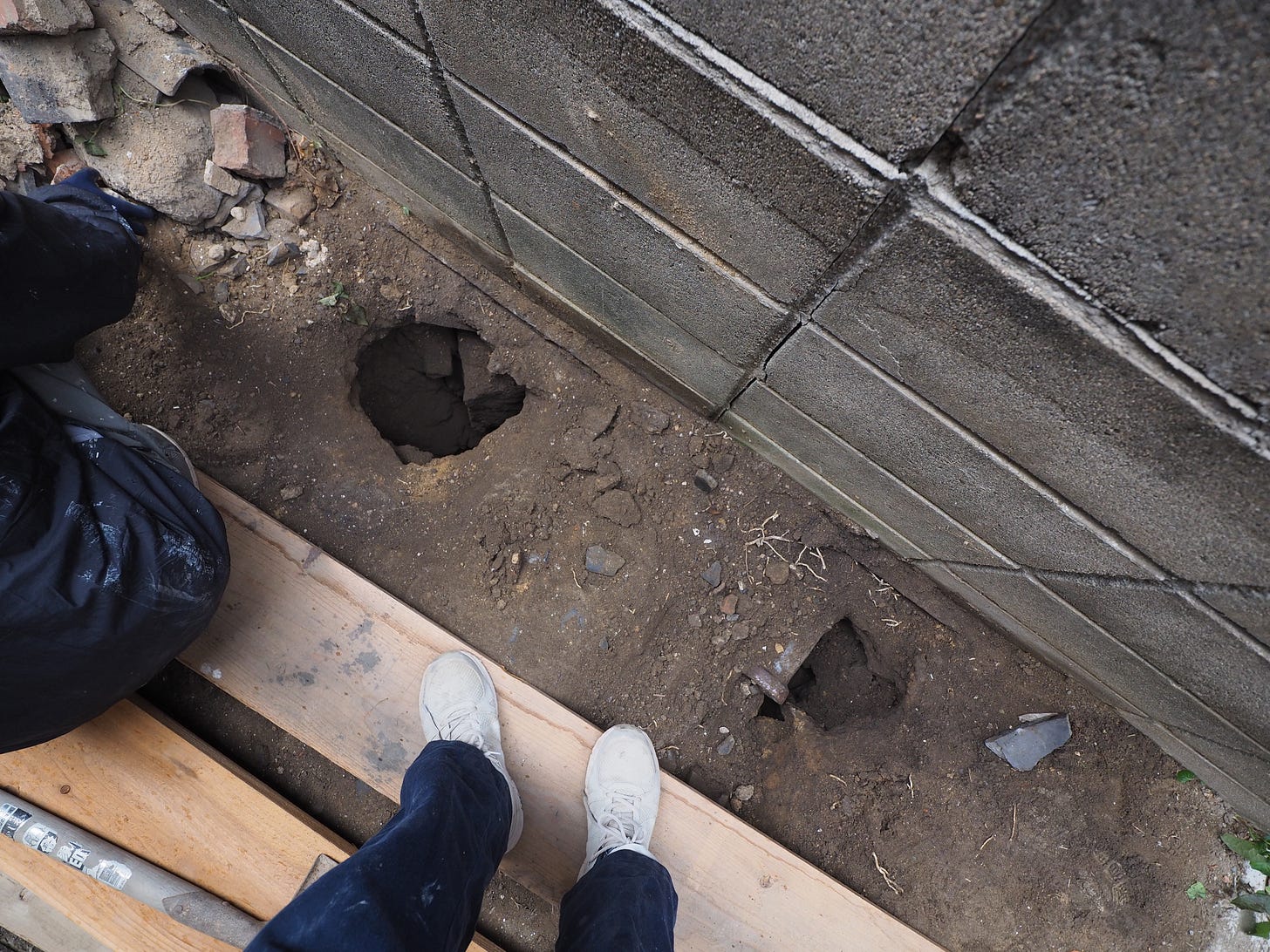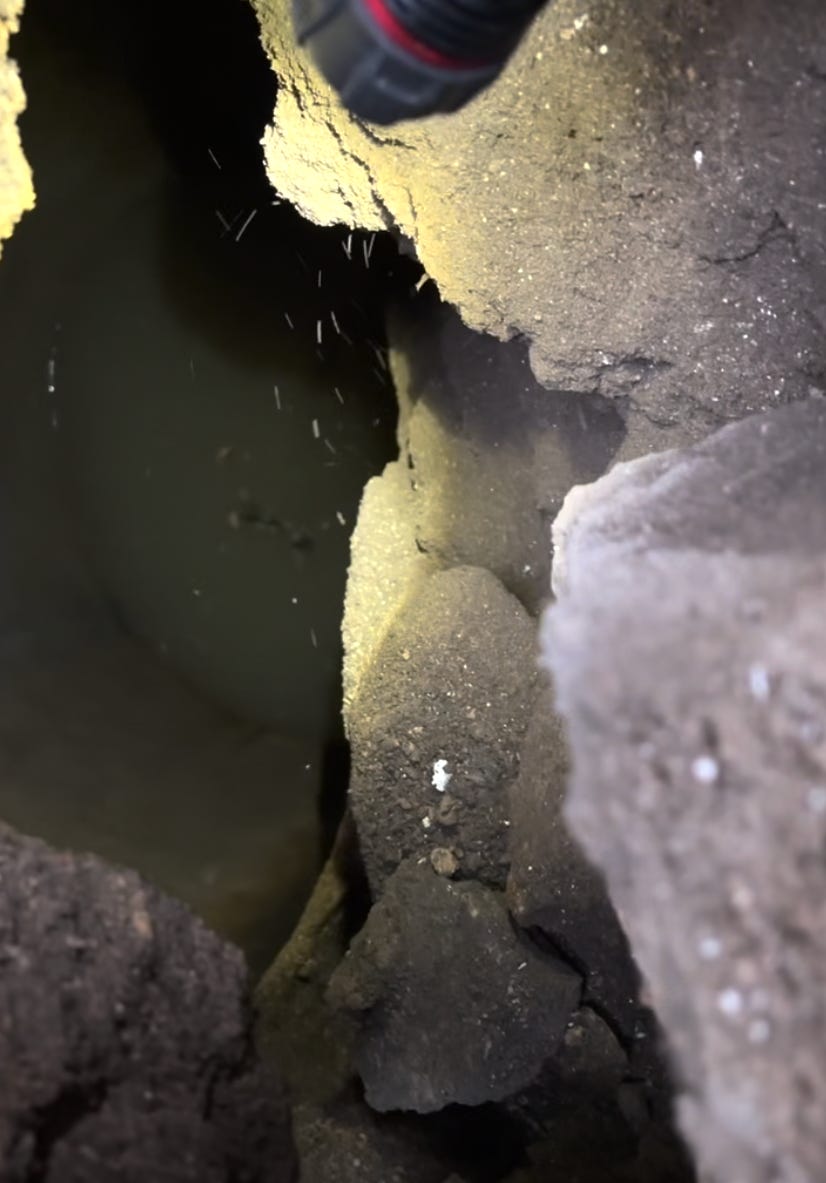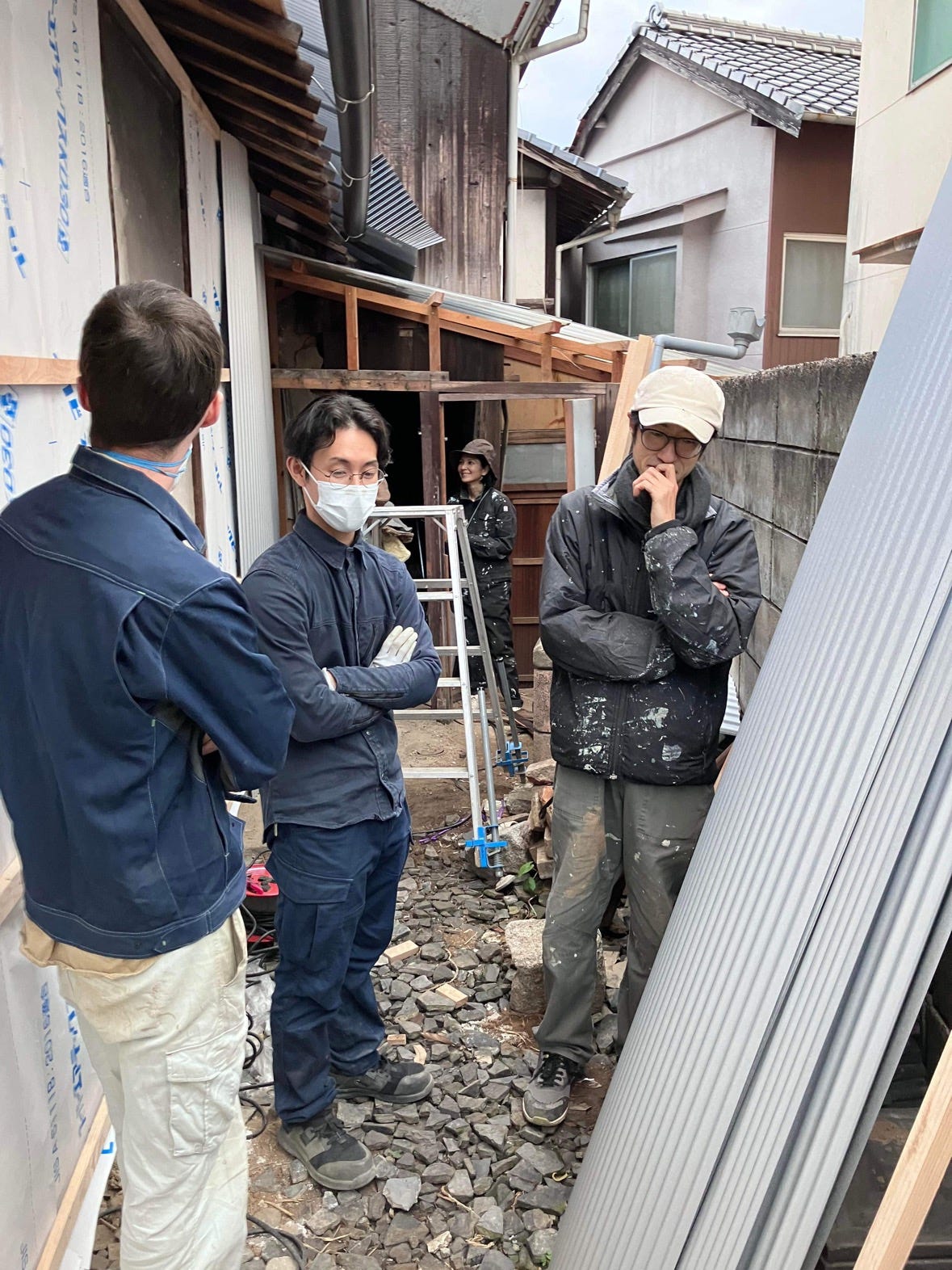The hole beneath our house
On hidden pitfalls and vanished mountains
What to do when we discover our foundations don’t in fact rest on solid ground? 2023 was another year when reassuring assumptions gave way to the unsettling realities of the present and future—the hottest year in human history, when fascists gathered at the gates and tech messiahs promised to destroy life as we know it. The structures of the past teeter tenuously on the precipice of the void.
But I actually mean the question here quite literally—what to do about the fact that the wall of our house straddles a gaping hole, like a piece of biscotti resting on the rim of a coffee mug? Perhaps like you, I spent too much of 2023 thinking about enormous problems over which I have absolutely no direct influence. A cavity beneath one’s house at least has the redeeming quality of being a conundrum neatly defined in physical space, with a range of actionable solutions. I wouldn’t quite say I recommend it to anyone, but if you’re gonna have problems to worry about, the theres-a-f***ing-hole-under-my-house variety is not as bad as it may sound. It certainly beats doomscrolling.
Let’s back up a minute. In late November, I gathered with the Labyrinth House team in Onomichi for our 23rd week of construction. We’re now three years into a self-funded, self-built renovation project. Of the three houses we received for free, completion of the second house is on the horizon—if all goes to plan, by this fall we’ll have a livable space and a general store open to the community (more on our plans in coming days).
On the first day of work in November, we put some students to work digging for an old pipe between the kitchen and the ditch along the edge of the property that we thought we might reuse for wastewater. They found the pipe, but as they excavated around it, a seemingly bottomless cavity opened up. Sounds like there’s water down there! Clumps of soil tumbled into the dark and triggered, a long moment later, a satisfying plop. A well.
Stumbling upon a well is not all that uncommon (there’s a whole sub-genre of the Japanese blogosphere). Wells, of course, used to be everywhere. There’s one just down the hill from us that we pass by all the time, with two platforms for residents at different elevations to take water. When the renovation NPO in town was first pulling apart the old clothing store that became their headquarters behind the station, they discovered one underneath the floor and turned it into table.
Wells can come in handy during disasters, so having one on the property was not necessarily a bad thing. Then we stuck a tape measure inside and realized how big it was—about five meters deep and a meter and a half in diameter, which means it extends at least 60 centimeters beneath the foundation of the bathroom wall. A well directly beneath the house. That’s some real Murakami shit, a friend replied on Instagram. At least the presence of a water vein explains why the ground was often damp in this corner of the house.
Most likely, the well was dug sometime in the early 20th century and used by the 3-4 houses in the immediate vicinity. When the municipal water supply eventually came to the hillside, they capped it and the owner of our house decided to build a new bath on top. As one does, of course! But why didn’t they fill it in first?
The first answer is that wells are inhabited by gods in Japan. When you’re done with a well, be sure to cover it up and stick a pipe in to allow the god to breathe. If we do have to mess with the well (perhaps to reduce the diameter), a Shinto priest will be called to ensure we are safe from any curses.
Of course, there is also a practical reason, besides the benefit in times of disaster—the same reason why the energy drained out of our bodies after the discovery. Eight cubic meters is a heck of a lot of volume to fill, so capping is a far easier option. We can’t simply call in a dump truck full of gravel. Being 150 stairs above the nearest road means realistically, any ballast would need to be sourced locally and moved by hand: jackhammering down aging concrete block walls, tossing in old roof tiles, etc. At least a week of backbreaking labor.
We stood around dumbfounded for some time around after the discovery. My mind unspooled from the tightly-bound preoccupations of that day’s work to consider all that still has to be done, how much further “finishing” just slipped away. I wandered through dark scenes of the future: the mosaic tile wall of my bath slipping into a sinkhole, and the stone walls of Onomichi crumbling as the seas rise; the twilight of democracy and the dying sun swallowing the earth. What urge possessed us to try to keep the laws of entropy at bay in this one tiny corner of the world?
When feelings of futility kick in, it’s time to crack open some beers.
Around the seventh week of construction in the fall of 2021, I had just returned to Onomichi from Tokyo after our hiatus during the hot summer months. At the time, we were renovating the main house, so we lived in another empty house owned by our neighbor, on the far side of the patch of vacant land where we have bonfires in the evenings. This house had a spectacular view of the waterfront from the second floor, where we all slept on futons.
It was also quite literally hanging off a cliff. The torrential rains of 2018 had swept away the chunk of earth beneath the entrance and bathroom. The post-disaster appraisers looked at it and designated the house as “totally destroyed,” which meant it would be eligible for public subsidies for demolition. Instead, our neighbor decided to prop up the entrance with some steel pipes. That’s how we had a place to live while we rebuilt Labyrinth House.
After I took a shower, Yu and I were sitting around in the living room, and he asked if anything seemed different than the spring. I wasn’t exactly sure what he was referring to. Does it seem more slanted? Now that he mentioned it…maybe? It was hard to say for sure—the entrance and bath were already drooping over a cliff face. Instead of running straight to the drain at the center of the room, the shower water would slosh along the south wall, then pool near the southwest corner before rising high enough to dribble into the drain. It can be rather difficult to notice gradual changes when you’re starting from a slant.
Nothing is level or straight up on the hill. Labyrinth House was built bit by bit over decades, iterating on what came before. Opening up a first-floor ceiling sometimes reveals an old roof left in place, with the floor beams of the second-level addition stacked atop the rafters. When capping a well or adding a room, nobody gave the slightest thought as to whether, a half century later, we might have appreciated if they had done things a bit more proper. I suppose that’s why we were surprised, but also not surprised, to find the well.
A few days before the end of the year I was in Arita, in the hills an hour north of Nagasaki, gazing at a mountain that no longer exists. Arita is famed as the home of Japanese porcelain, which like most things people associate with Japan isn’t actually from Japan. When Toyotomi’s army came slinking back from Korea at the end of the 16th century, the lord of Saga brought back a Korean potter named Yi Sam-pyeong. He went in search of kaolin soil and discovered a deposit here. And because of that, today all over the town and in the little villages nearby sprout dozens of red brick kiln smokestacks.
A friend opened a beautiful new tea shop here in November, along the main road lined with century-old shophouses. The porcelain galleries offer endless choices. Eventually our own desire settled on two small hand-painted gems: a plate of flying swallows and a bowl with two rats nibbling on a daikon radish. I complemented the shopkeeper on the well-kept building as he wrapped up our purchases. This year it’s 101 years old. Ah, the second year of Taisho. Why yes! The navy wanted the route to Sasebo widened, so most of the buildings were rebuilt then with facades neatly abutting the road. That’s more or less how it is today, a cohesive historic district of the sort you don’t find in the big cities.
And then there’s the old quarry. 400 years of civilization measured not in edifice, but absence. Just a big, empty space where a mountain used to be. My mind tried to fill it with 1.5-meter wide, 5-meter long tubes, like counting jelly beans in a jar. How many wells fit inside a mountain? Answer: a lot. My problem seemed a little smaller.
I thought of the tens of millions of plates spun from all this soil, spirited off to the palaces of Amsterdam and London, the crowded restaurants of Edo and Kyoto and the minimalist condos of San Francisco and Oslo, and that keep getting churned out of the kilns at a velocity fast enough to sustain a whole community today.
Wells notwithstanding, I’m hopeful we can complete this stage of Labyrinth House this year and move the project (and life) forward to a new phase. We will be starting a crowdfunding campaign in the next few weeks, so more to come soon about the journey.





